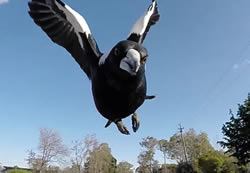John Elder* says there are many colourful theories about why magpies attack humans during the breeding season, but most don’t hold up to scrutiny.
 Two questions come to mind when you’ve been attacked by a magpie: Will I ever see out of that eye again? (A small number of people actually lose an eye each year, including small children).
Two questions come to mind when you’ve been attacked by a magpie: Will I ever see out of that eye again? (A small number of people actually lose an eye each year, including small children).
And why me?
The mystery of why some magpies swoop human beings so aggressively during breeding season has led to some colourful theories.
One idea is that randy male magpies — like many neglected fathers of newborns — develop a case of blue balls and angrily take it out on passers-by.
There is some science in there: all male birds have a spike in testosterone at baby-making time.
This can lead to aggressive behaviour, including attacks on other birds in the lead-up to breeding season.
But by the time the eggs are laid, the testosterone levels fall away.
A 1991 study of Australian magpies confirmed the drop in testosterone, but the theory has lingered.
Dr Darryl Jones is Professor and Deputy Director of the Environmental Futures Research Institute and School of Environment and Science at Griffith University.
He spent seven years researching why magpies swoop — and along the way ruled out the myths that have persisted.
“We looked at every possible thing,” he said.
“Some people said it was the colour yellow or because girls had long hair.”
“We examined every single theory and none of them came out as sensible.’’
In 2010, Dr Jones and his fellow researchers published a paper in the journal Emu that examined the three prevailing theories, titled “Attacks on humans by Australian Magpies (Cracticus tibicen): Territoriality, brood-defence or testosterone?”.
Heightened testosterone was discounted immediately because the timing was wrong: the attacks only occur when there are chicks in the nest.
The theory that male birds are defending their territory was also discounted for two good reasons: territoriality is the defending of a territory from birds of the same species — other magpies.
Also, unusually in the bird world, magpies defend their territories all year round.
The attacks only occur when breeding is in play and the attacks occur when the magpie believes the nest is under threat from a predator.
Dr Jones and company found that about 10 per cent of magpies “never do something aggressive to a human’’.
Overwhelmingly, the attackers are males — but, on rare occasions, says Dr Jones, a female will get involved as well, but only if her mate has launched an attack.
“In that case, they would be over-stressed magpies that are being harassed by humans and go nuts, but that’s an extreme,’’ he said.
“Most magpies don’t look sideways at people.”
“The attacks are made when something has been interpreted as a threat, something that they feel a predator might do.”
“It’s all about defending the nest.’’
So what exactly sets off a magpie?
It’s still to be determined, but there seems to be a greater chance of an attack in places where lots of people are walking about — such as parks, school playgrounds and carparks — causing elevated stress.
But more often than not it seems to be very personal.
Magpies do remember faces.
Over a number of years, Dr Jones carried out an experiment where he would sit in his car — safe from harm — while his students would walk around trees occupied by nesting magpies, some of them looking up directly at the nest as they walked about.
Initially there wasn’t a response.
But after about five prying visits, the male began to attack — but only going for the student who did the staring.
The initial swoop was a general fly-over.
But as the staring continued, the magpie swooped closer.
“And the magpie remembered that person for years,’’ Dr Jones says.
A magpie weighs up to 350 g — a bit less than a block of butter.
But with its sharp, pointed beak — designed for digging in the earth for prey — it’s like being hit with a spear at a serious clip.
There isn’t a clear idea of how fast they swoop, but around 70 km/h is a commonly cited estimate.
How to avoid getting hit?
The best solution is to keep clear of nesting trees identified as home to swoopers by your local Council.
* John Elder is an Australian journalist.
This article first appeared at thenewdaily.com.au/.


